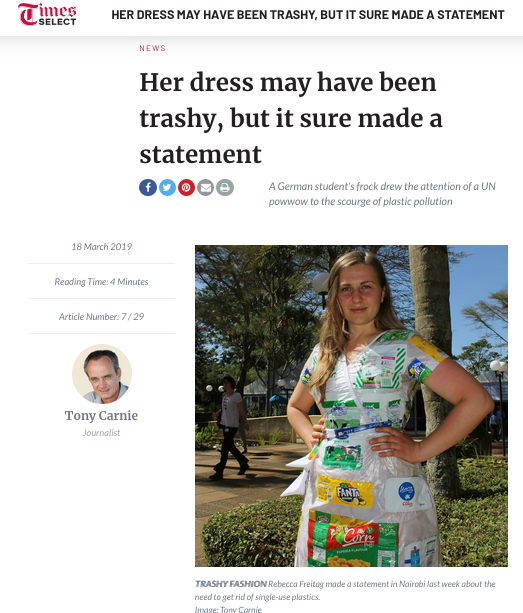
Her dress may have been trashy, but it sure made a statement
A German student’s frock drew the attention of a UN powwow to the scourge of plastic pollution
18 March 2019
Reading Time: 4 Minutes
Article Number: 7 / 29
Journalist
TRASHY FASHION Rebecca Freitag made a statement in Nairobi last week about the need to get rid of single-use plastics.
Image: Tony Carnie
Rebecca was not wearing the prettiest or the most fashionable dress.
Truth be told, her dress was rather frumpy and trashy – yet she still managed to make a bold statement without uttering a word at a global environmental conference in Kenya last week.
“The world is drowning in plastic, but the current generation of leaders seems happy to leave it up to us as young people to clean up their mess,” Rebecca Freitag told Times Select at the 4th United Nations Environment Assembly in Nairobi.
Her outlandish white dress – festooned with a garish assortment of brightly coloured potato chip packets, soft-drink labels and detergent sachets – was meant to highlight the scourge of plastic polluting the world’s oceans.
I have only been wearing this dress for an hour, but already so many people are smiling, giving me ‘thumbs up’ signals or asking whether they can take selfies with me in this wretched dress.
Freitag, a 26-year-old student at Humboldt University in Berlin, seemed a bit surprised by all the attention she was attracting at the Nairobi event, where nearly 4,000 delegates from 170 nations met to discuss plastic pollution and a wide range of other global environmental challenges.
“I have only been wearing this dress for an hour, but already so many people are smiling, giving me ‘thumbs up’ signals or asking whether they can take selfies with me in this wretched dress.”
Freitag, an official youth delegate for sustainable development of the German federal ministry of the environment, stressed she was making a personal statement.
“We now have plastic in children’s toys, in women’s personal hygiene products. Well, actually, it is just everywhere and, on behalf of the youth, we are demanding a seat at the global negotiating table.
“Though I am a delegate, I cannot speak or make important decisions and, after looking at the draft resolutions from this conference about reducing plastic pollution, I can see that they are not ambitious enough.
“We believe there should be a strong political framework put in place to reduce plastics, rather than trying to shift the blame onto consumers.
“I think it is crazy that supermarkets are still encouraging the global throwaway culture by selling peeled slices of bananas or mandarin oranges in plastic containers covered by plastic cling film.
“Today it is cheaper to buy a new dress or a printer machine rather than to repair the ones you have already.
“So we need to look far beyond just recycling, to redesigning anything made from plastic,” Freitag said.
PLASTIC HELL Plastic litter has become a menace on beaches across the world. This was the scene at the mouth of Durban’s Umgeni River earlier this week after heavy downpours.
Image: Andrew Zaloumis
Inside the main conference halls, plastic pollution had nevertheless emerged as an important theme.
Acting UN Environment Programme executive director Joyce Msuya suggested it was not an easy political decision for some countries to ban single-use plastics.
Tackled by a Kenyan delegate who wanted to know how young people could support efforts to curb plastic pollution, the Tanzanian-born environmental scientist and former World Bank adviser responded: “We need people marching in the streets, particularly those people who speak the hashtag language. You must hold us accountable. You must raise your voices and mobilise,” said Msuya.
Last month, a report entitled The Hidden Costs of a Plastic Planet suggested nearly two-thirds of all plastic ever produced remained in the environment in some form – as debris in the oceans, as microparticles or nanoparticles in air and agricultural soils, as microfibres in water supplies, or as microparticles in the human body.
Published by the Centre for International Environmental Law, the report says mass-produced plastic entered the global market after World War 2.
Lead author David Azoulay said a recent analysis of all plastic ever made estimated that 8,300 million metric tons of virgin plastic had been produced by 2015.
“As a result of the global shift from reusable to single-use packaging [including containers], the most significant market for plastic today is packaging and comprises 42% of all plastic ever produced.
“Packaging is also the product with the shortest lifespan. Most plastic packaging leaves the economy the same year it is produced because most is designed for a single use,” the report stated.
I think it is crazy that supermarkets are still encouraging the global throw-away culture by selling mandarin oranges in plastic containers covered by plastic cling film.
Azoulay and his colleagues said emerging data had also demonstrated the presence of microparticles and nanoparticles of plastic (including toxic chemical additives) in food, air and water, raising concerns among scientists about their potential impacts on human health.
“Though our understanding of the impacts of micro and nanoparticles of plastic on human health is limited, the emerging body of research is raising fundamental questions about the historic belief that plastic is inert and safe.
“Increasingly, the research demonstrates that the same characteristics that make plastic a material with diverse and desirable applications for bettering human life … also make them widely dispersed, ubiquitous and a potential threat to human life and the ecosystems upon which humans rely.”
